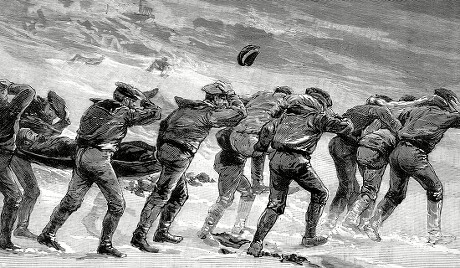A Comparison of Perspectives
Chapter 12 of The Rescue of Greely recounts the apex of the mission, where the rescue team finally locates and saves Lieutenant Greely and the surviving members of his expedition. In the entry, Schley and Soley write in a structured manner, chronologically narrating the strategy and organization behind the rescue mission and eventual discovery of the camp. The account is polished and reverent, with a clear emotional arc built by the authors to highlight the heroism and resilience of the rescuers and those rescued. On the other hand, Johnson’s diary entry presents raw, immediate, and visceral descriptions, capturing morbid details not clearly mentioned in the book. For example, Johnson’s first encounter with one of the Greely survivors, as described in his diary, is not recorded in The Rescue of Greely. Johnson states,
“[the] first man seen on shore when we landed was sergent Lang hee was standing on a hill with a [blancket]wrapped around his body and his mouth [Completely] covered around with blood [saying ] that he needed the blood of two [Ducks] that where [found] back of the Camp he being the Hunter and therefore had the right to suck the blood for nourishment in order to keep himself strong when asked by some of the men weather he was one of the Greely party to wich he answered yes” (P.W. Johnson 39). *
This encounter is not described in any other historical document regarding the Greely Relief Expedition. The graphic description of “suck[ing] blood for nourishment” is striking and most likely deemed inappropriate to share with the public. Therefore, tragic and gruesome details have been intentionally left out of the story to push a heroic narrative of the rescuers and survivors.
While both sources were written by individuals who were on the same rescue mission, the published book was written in a much more formal and academic writing style that uses narrative techniques to paint a picture of resilience and courage in a very harsh reality. Johnson’s tone is significantly more distressed and somber, focusing on the harshness of the moment with unfiltered observations.
For instance, when the survivors were discovered, the descriptions of their conditions were blunt and vivid. Johnson writes, “one of the Survivors Maurice Cornel was brought onboard half dead he being cold from his Neck dowwn and in one hour more he would undoublty died” (pg 39)*. Johnson does not glamorize the situation and instead writes with a tone of realness, followed by raw emotion detailing the role that religious prayer had in this desperate moment. “When found in Camys Leut Greely was reading Prayers out of the Bible to his brave dying Comerade” (P.W. Johnson 39)*. P.W. Johnson’s account humanizes this moment, not only stating how one of the seven survivors passed away, but showing a glimpse of those last few moments of bravery and despair and emotion.
His chaotic writing style– as depicted by the lack of periods, spelling inconsistencies, unclear wording, and fragmented sentences– adds to the rawness of the narrative, conveying the story as one of horror and pity, rather than heroism. For example, Johnson describes first discovering the men surrounded by multiple unburied bodies stating, “Camp Exhumed the bodies of 10 dead [burried] back of Camp wrapped them in Blankets and labeled them as follows…the bodies of [Sergent] Henry and Private Sohneider [werre] found on the ice unburied carried all the bodies on board the Theites” (P.W. Johnson 39).* He often uses graphic words to detail finding dead bodies and blood. However, chapter 12 of the book, which addresses the same encounter, does not even mention the word “blood,” highlighting the contrasting narratives being pushed. For one, the survivors are portrayed as respected, courageous, and resilient in the book, whereas Johnson portrays them to be animalistic and dehumanized as they near their deaths.
* Transcribed Fall of 2024. Transcription subject to change.

